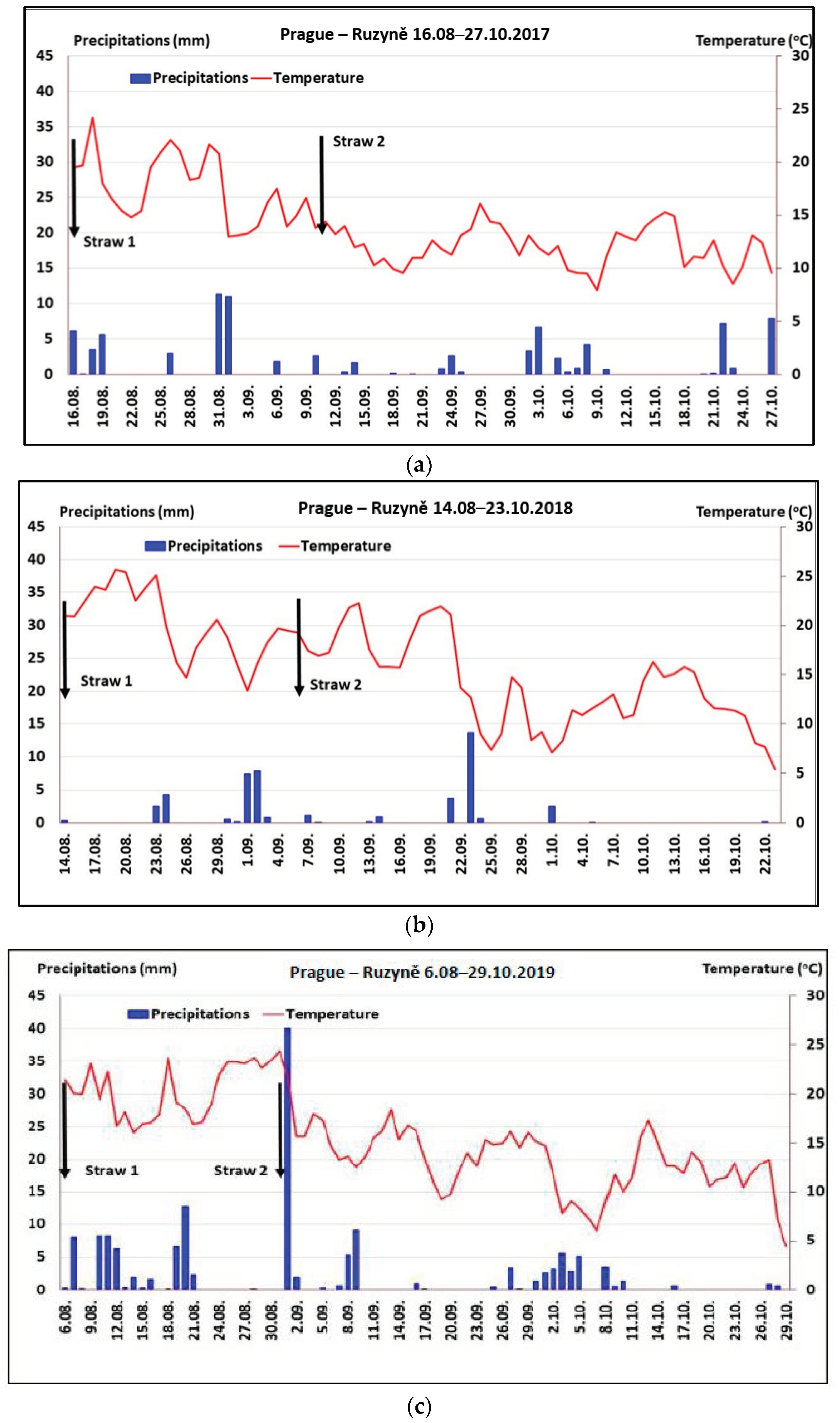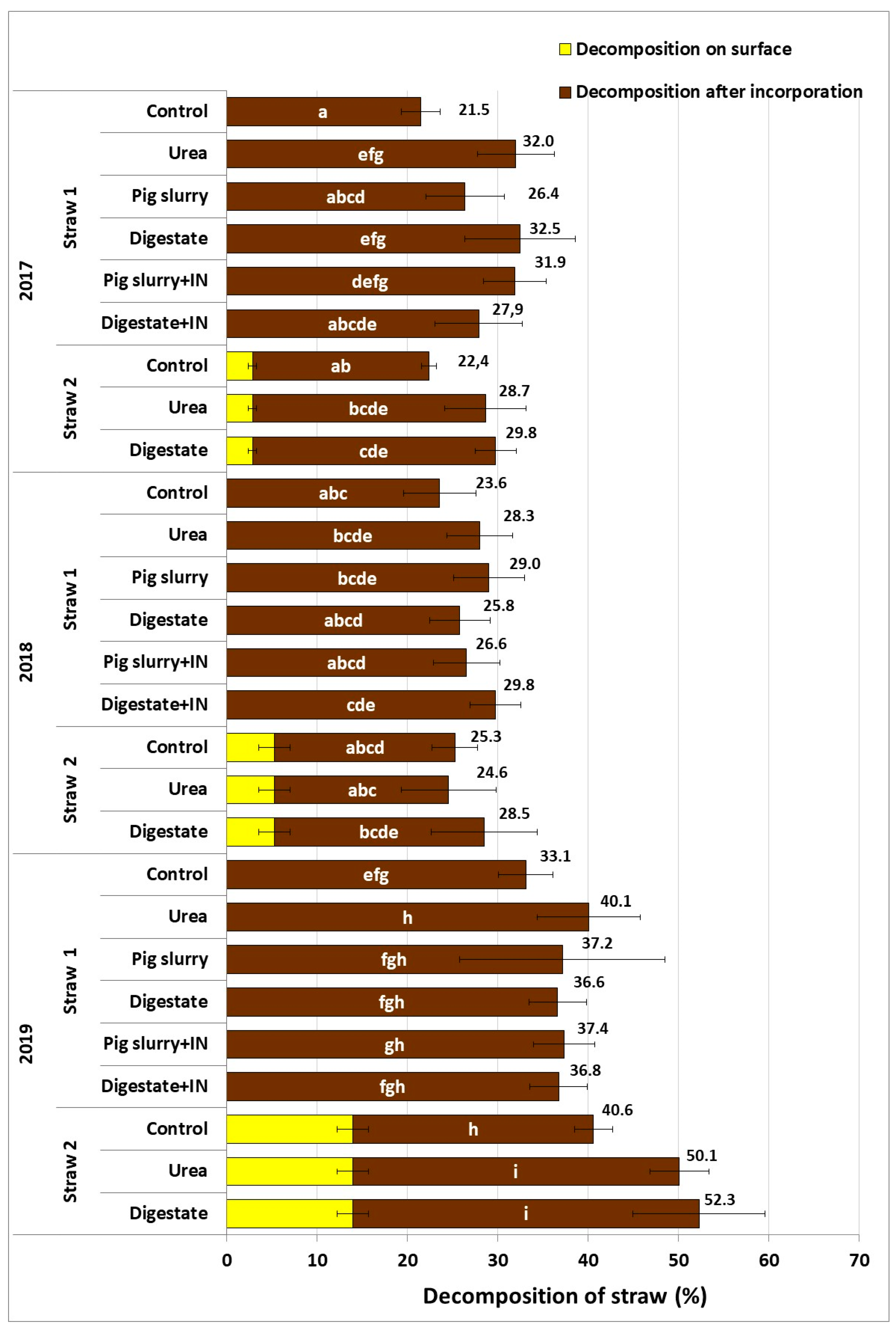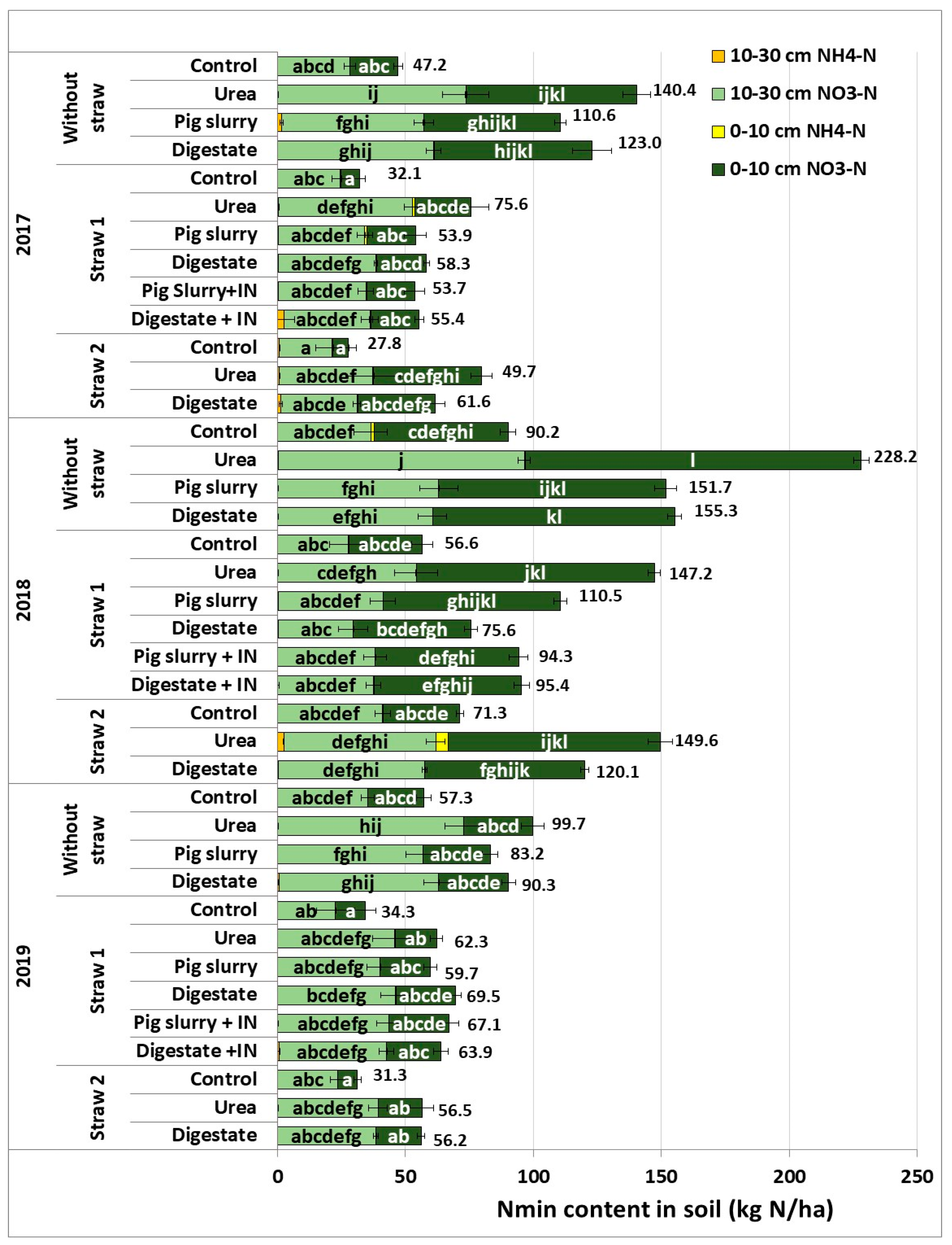Winter Wheat Straw Decomposition under Different Nitrogen Fertilizers
Abstract
:1. Introduction
2. Materials and Methods
2.1. Field Experiment
2.2. Precipitation and Temperature
2.3. Statistical Analysis
3. Results
3.1. Straw Decomposition and Fertiliser Effect
3.2. Mineral Nitrogen (Nmin) Content in Soils
4. Discussion
5. Conclusions
Author Contributions
Funding
Institutional Review Board Statement
Informed Consent Statement
Data Availability Statement
Acknowledgments
Conflicts of Interest
References
- Veres, Z.; Kotroczó, Z.; Fekete, I.; Tóth, J.A.; Lajtha, K.; Townsend, K.; Tóthmérész, B. Soil extracellular enzyme activities are sensitive indicators of detrital inputs and carbon availability. Appl. Soil Ecol. 2015, 92, 18–23. [Google Scholar] [CrossRef]
- Han, X.; Xu, C.; Dungait, J.A.J.; Bol, R.; Wang, X.J.; Wu, W.L.; Meng, F.Q. Straw incorporation increases crop yield and soil organic carbon sequestration but varies under different natural conditions and farming practices in China: A system analysis. Biosciences 2018, 15, 1933–1946. [Google Scholar] [CrossRef] [Green Version]
- Tisdale, S.L.; Nelson, W.L.; Beaton, J.D. Soil Fertility and Fertilizers; Macmillan Publishing Company: New York, NY, USA, 1985. [Google Scholar]
- Govumoni, S.P. Evaluation of Pretreatment Methods for Enzymatic Saccharification of Wheat Straw for Bioethanol Production. Carbohydr. Polym. 2013, 91, 646–650. [Google Scholar] [CrossRef] [PubMed]
- FAO. Available online: http://www.fao.org/faostat/en/#data/QC (accessed on 23 November 2020).
- FAO. Available online: http://www.fao.org/worldfoodsituation/csdb/en/#:~:text=FAO%E2%80%99s%20forecast%20for%20world%20wheat%20production%20in%202020,record%20high%20level%20of%20around%20765%20million%20tons (accessed on 23 November 2020).
- Li, H.; Cao, Y.; Wang, X.; Ge, X.; Li, B.; Jin, C. Evaluation on the production of food crop straw in China from 2006 to 2014. BioEnergy Res. 2017, 10, 949–957. [Google Scholar] [CrossRef]
- Zhao, S.; Li, K.; Zhou, W.; Qiu, S.; Huang, S.; He, P. Changes in soil microbial community, enzyme activities and organic matter fractions under long–term straw return in north–central China. Agric. Ecosyst. Environ. 2016, 216, 82–88. [Google Scholar] [CrossRef]
- Wei, T.; Zhang, P.; Wang, K.; Ding, R.; Yang, R.; Yang, B.; Nie, J.; Jia, Z.; Han, Q. Effects of Wheat Straw Incorporation on the Availability of Soil Nutrients and Enzyme Activities in Semiarid Areas. PLoS ONE 2015, 10, e0120994. [Google Scholar] [CrossRef] [Green Version]
- Meng, F.Q.; Dungait, J.A.J.; Xu, X.L.; Bol, R.; Zhang, X.; Wu, W.L. Coupled incorporation of maize (Zea mays L.) straw with nitrogen fertilizer increased soil organic carbon in Fluvic Cambisol. Geoderma 2017, 304, 19–27. [Google Scholar] [CrossRef]
- Zhao, S.; Xiu, S.; Xu, X.; Ciampitti, I.A.; Zhang, S.; He, P. Change in straw decomposition rate and soil microbial community composition after straw addition in different long-term fertilization soils. Appl. Soil Ecol. 2019, 138, 123–133. [Google Scholar] [CrossRef]
- Neff, J.C.; Townsend, A.R.; Gleixner, G.; Lehman, S.J.; Turnbull, J.; Bowman, W.D. Variable effects of nitrogen additions on the stability and turnover of soil carbon. Nature 2002, 419, 915–917. [Google Scholar] [CrossRef]
- Potthoff, M.; Dyckmans, J.; Flessa, H.; Muhs, A.; Beese, F.; Joergensen, R.G. Dynamics of maize (Zea mays L.) leaf straw mineralization as affected by the presence of soil and the availability of nitrogen. Soil Biol. Biochem. 2005, 37, 1259–1266. [Google Scholar] [CrossRef]
- Kaspari, M.; Garcia, M.N.; Harms, K.E.; Santana, M.; Wright, S.J.; Yavitt, J.B. Multiple nutrients limit litterfall and decomposition in a tropical forest. Ecol. Lett. 2008, 11, 35–43. [Google Scholar] [CrossRef] [PubMed]
- Hobbie, S.E.; Eddy, W.C.; Buyarski, C.R.; Adair, E.C.; Ogdahl, M.L.; Weisenhorn, P. Response of decomposing litter and its microbial community to multiple forms of nitrogen enrichment. Ecol. Monogr. 2012, 82, 389–405. [Google Scholar] [CrossRef]
- Wu, L.W.; Yang, Y.F.; Chen, S.; Shi, Z.J.; Zhao, M.X.; Zhu, Z.W.; He, Q. Microbial functional trait of rRNA operon copy numbers increases with organic levels in anaerobic digesters. ISME J. 2017, 11, 2874–2878. [Google Scholar] [CrossRef] [PubMed]
- Zhang, P.; Wei, T.; Li, Y.L.; Wang, K.; Jia, Z.K.; Han, Q.F.; Ren, X.L. Effects of straw incorporation on the stratification of the soil organic C, total N and C:N ratio in a semiarid region of China. Soil Till. Res. 2015, 153, 28–35. [Google Scholar] [CrossRef]
- Yang, H.; Meng, Y.; Feng, J.; Li, Y.; Zhai, S.; Liu, J. Direct and indirect effects of long-term ditch-buried straw return on soil bacterial community in a rice–wheat rotation system. Land Degrad. Dev. 2019. [Google Scholar] [CrossRef]
- Cyle, K.T.; Hill, N.; Young, K.; Jenkins, T.; Hancock, D.; Schroeder, P.A. Substrate quality influences organic matter accumulation in the soil silt and clay fraction. Soil Biol. Biochem. 2016, 103, 138–148. [Google Scholar] [CrossRef] [Green Version]
- Bremner, J.M. Recent research on problems in the use of urea as a nitrogen fertilizer, 1995. Fertil. Res. 1995, 42, 321–329. [Google Scholar] [CrossRef]
- Bremner, J.M.; Krogmeier, M.J. Evidence that the adverse effect of urea fertilizer on seed germination in soil is due to ammonia formed through hydrolysis of urea by soil urease. Proc. Natl. Acad. Sci. USA 1989, 86, 8185–8188. [Google Scholar] [CrossRef] [Green Version]
- Kowalski, Z.; Makara, A.; Fijorek, K. Changes in the properties of pig manure slurry. Biochim. Polonica 2013, 30, 845–850. Available online: www.actabp.pl (accessed on 3 January 2021). [CrossRef] [Green Version]
- Antezana, W.; De Blas, C.; García-Rebollar, P.; Rodríguez, C.; Beccaccia, A.; Ferrer, P.; Cerisuelo, A.; Moset, V.; Estellés, F.; Cambra-lópez, M.; et al. Composition, potential emissions and agricultural value of pig slurry from Spanish commercial farms. Nutr. Cycl. Agrosyst. 2016, 104, 159–173. [Google Scholar] [CrossRef] [Green Version]
- Aita, C.; Recous, S.; Cargnin, R.H.O.; da Luz, L.P.; Giacomini, S.J. Impact on C and N dynamics of simultaneous application of pig slurry and wheat straw, as affected by their initial locations in soil. Biol. Fertil. Soils 2012, 48, 633–642. [Google Scholar] [CrossRef]
- Risberg, K.; Cederl, H.; Pell, M.; Arthurson, V.; Schnürer, A. Comparative characterization of digestate versus pig slurry and cow manure—Chemical composition and effects on soil microbial aktivity. Waste Manag. 2017, 61, 529–538. [Google Scholar] [CrossRef] [PubMed]
- Weiland, P. Biogas production: Current state and perspectives. Appl. Microbiol. Biotechnol. 2010, 85, 849–860. [Google Scholar] [CrossRef] [PubMed]
- Insam, H.; Gómez-Brandón, M.; Ascher, J. Manure-based biogas fermentation residues—Fried or foe of soil fertility? Soil Biol. Biochem. 2015, 84, 1–14. [Google Scholar] [CrossRef]
- Šimon, T.; Kunzová, E.; Friedlová, M. The effect of cattle slurry and mineral fertilization on the winter wheat yield and soil quality parameters. Plant Soil Environ. 2015, 61, 522–527. [Google Scholar] [CrossRef] [Green Version]
- Gao, H.; Wei, J.; Zhang, Y.; Zhang, L.; Chang, J.; Thompson, M.L. Decomposition Dynamics and Changes in Chemical Composition of Wheat Straw Residue under Anaerobic and Aerobic Conditions. PLoS ONE 2016, 11, e0158172. [Google Scholar] [CrossRef] [Green Version]
- Tulina, A.S.; Semenov, V.M.; Rozanova, L.N.; Kuznetsova, T.V.; Semenova, N.A. Influence of moisture on the stability of soil organic matter and plant residues. Eur. Soil Sci. 2009, 42, 1241–1248. [Google Scholar] [CrossRef]
- Lopez-Sangil, L.; Hartley, I.P.; Rovira, P.; Casals, P.; Sayer, E.J. Drying and rewetting conditions differentially affect the mineralization of fresh plant litter and extant soil organic matter. Soil Biol. Biochem. 2018, 124, 81–89. [Google Scholar] [CrossRef] [Green Version]
- Regulation of Czech Republic No: 262/2012 on Identification of Vulnerable Areas and Action Program. Available online: https://www.zakonyprolidi.cz/cs/2012-262 (accessed on 11 February 2020).
- Fan, F.L.; Yu, B.; Wang, B.R.; George, T.S.; Yin, H.Q.; Xu, D.Y.; Li, D.C.; Song, A.L. Microbial mechanisms of the contrast residue decomposition and priming effect in soils with different organic and chemical fertilization histories. Soil Biol. Biochem. 2019, 135, 213–221. [Google Scholar] [CrossRef]
- Turk, A.; Mihelič, R. Wheat straw decomposition, N-mineralization and microbial biomass after 5 years of conservation tillage in Gleysol field. Acta Agric. Slov. 2013, 101, 69–75. [Google Scholar] [CrossRef]
- Bhardwaj, K.K.R.; Novák, B. Effect of Moisture Level on Nitrogen Immobilization as Affected by Wheat Straw Decomposition in Soil. Zentralblatt für Bakteriologie, Parasitenkunde, Infektionskrankheiten und Hygiene. Zweite Naturwissenschaftliche Abteilung: Mikrobiologie der Landwirtschaft. Technol. Umweltschutzes 1978, 133, 471–476. [Google Scholar]
- Franzluebbers, A.J. Soil organic matter stratification ratio as an indicator of soil quality. Soil Till. Res. 2002, 66, 95–106. [Google Scholar] [CrossRef]
- Balota, E.L.; Colozzi-Filho, A.; Andrade, D.S.; Richard, P.D. Microbial biomass in soils under different tillage and crop rotation systems. Biol. Fertil. Soils 2003, 38, 15–20. [Google Scholar] [CrossRef]
- Schomberg, H.H.; Steiner, J.L.; Unger, P.W. Decomposition and nitrogen dynamics of crop residues—Residue quality and water effects. Soil Sci. Soc. Am. J. 1994, 58, 72–381. [Google Scholar] [CrossRef] [Green Version]
- Geisseler, D.; Horwath, W.R.; Joergensen, R.G.; Ludwig, B. Pathways of nitrogen utilization by soil microorganisms—A review. Soil Biol. Biochem. 2010, 42, 2058–2067. [Google Scholar] [CrossRef]
- Vargas, V.P.; Soares, J.R.; Oliveira, B.G.; Lourenco, K.S.; Martins, A.A.; Del Grosso, S.J.; do Carmo, J.B.; Canratella, H. Sugarcane Straw, Soil Temperature, and Nitrification inhibitor Impact N2O Emissions from N Fertilizer. Bioenergy Res. 2019, 12, 801–812. [Google Scholar] [CrossRef]
- Sandor, M.S.; Brad, T.; Maxim, A.; Toader, C. The Influence of Selected Meteorological Factors on Microbial Biomass and Mineralization of Two Organic Fertilizers. Not. Bot. Horti Agrobot. Cluj-Napoca 2011, 39, 107–113. [Google Scholar] [CrossRef] [Green Version]
- Quan, Z.; Li, S.L.; Zhu, F.F.; Zhang, L.M.; He, J.Z.; Wei, W.X.; Fang, Y.T. Fates of N-15-labeled fertilizer in a black soil-maize system and the response to straw incorporation in Northeast China. J. Soil Sediment 2018, 18, 1441–1452. [Google Scholar] [CrossRef]
- Bhardwaj, K.K.R.; Novák, B. Effect of Moisture and Nitrogen Levels on the Decomposition of Wheat Straw in Soil. Zentralblatt für Bakteriologie, Parasitenkunde, Infektionskrankheiten und Hygiene. Zweite Naturwissenschaftliche Abteilung: Mikrobiologie der Landwirtschaft. Technol. Umweltschutzes 1978, 133, 477–482. [Google Scholar]
- Cheschire, M.V.; Bedrock, C.N.; Williams, B.L.; Chapman, S.J.; Solntseva, I.; Thompsen, I. The immobilization of nitrogen by straw decomposing in soil. Eur. J. Soil Sci. 1999, 50, 329–341. [Google Scholar] [CrossRef]
- Li, Z.H.; Ji, Q.; Zhao, S.X.; Wei, B.M.; Wang, X.D.; Hussain, Q. Changes in C and N fractions with composted manure plus chemical fertilizers applied in apple orchard soil: An in-situ field incubation study on the Loess Plateau, China. Soil Use Manag. 2018, 34, 276–285. [Google Scholar] [CrossRef]
- Pecheron, A.; Váry, Z.; Malla, K.B.; Halford, N.G.; Paul, M.J.; Doohan, F.M. The wheat SnRK1α family and its contribution to Fusarium toxin tolerance. Plant Sci. 2019, 288, 110217. [Google Scholar]
- Tang, C.; Xu, Q.; Zhao, M.; Wang, X.; Kang, Z. Understanding the lifestyles and pathogenicity mechanisms of obligate biotrophic fungi in wheat: The emerging genomics era. Crop J. 2018, 6, 60–67. [Google Scholar] [CrossRef]
- SAATEN-UNION, GmbH (2020). Available online: https://www.saaten-union.de/index.cfm (accessed on 15 February 2020).
- Nicholson, F.; Kindred, D.; Bhogal, A.; Roques, S.; Kerley, J.; Twining, S.; Brassington, T.; Gladers, P.; Balshaw, H.; Cook, S.; et al. Straw Incorporation Review. Tech. Rep. 2013, 74. [Google Scholar] [CrossRef]
- Freibauer, A.; Rounsevell, M.D.A.; Smith, P.; Verhagen, J. Carbon sequestration in the agricultural soils of Europe. Geoderma 2004, 122, 1–23. [Google Scholar] [CrossRef]



| Digestate | Pig Slurry | ||
|---|---|---|---|
| Dry matter | % | 6.30 | 5.60 |
| Ntot | % | 0.46 | 0.56 |
| NH4-N | % | 0.32 | 0.43 |
| pH | 8.07 | 6.97 | |
| P | % | 0.06 | 0.07 |
| K | % | 0.43 | 0.22 |
| Treatment | Straw |
|---|---|
| Control | 0 |
| Urea | 0 |
| Pig slurry | 0 |
| Digestate | 0 |
| Control | Straw1 |
| Urea | Straw1 |
| Pig slurry | Straw1 |
| Digestate | Straw1 |
| Pig slurry + IN | Straw1 |
| Digestate + IN | Straw1 |
| Control | Straw 2 |
| Urea | Straw 2 |
| Digestate | Straw 2 |
Publisher’s Note: MDPI stays neutral with regard to jurisdictional claims in published maps and institutional affiliations. |
© 2021 by the authors. Licensee MDPI, Basel, Switzerland. This article is an open access article distributed under the terms and conditions of the Creative Commons Attribution (CC BY) license (http://creativecommons.org/licenses/by/4.0/).
Share and Cite
Mühlbachová, G.; Růžek, P.; Kusá, H.; Vavera, R.; Káš, M. Winter Wheat Straw Decomposition under Different Nitrogen Fertilizers. Agriculture 2021, 11, 83. https://doi.org/10.3390/agriculture11020083
Mühlbachová G, Růžek P, Kusá H, Vavera R, Káš M. Winter Wheat Straw Decomposition under Different Nitrogen Fertilizers. Agriculture. 2021; 11(2):83. https://doi.org/10.3390/agriculture11020083
Chicago/Turabian StyleMühlbachová, Gabriela, Pavel Růžek, Helena Kusá, Radek Vavera, and Martin Káš. 2021. "Winter Wheat Straw Decomposition under Different Nitrogen Fertilizers" Agriculture 11, no. 2: 83. https://doi.org/10.3390/agriculture11020083
APA StyleMühlbachová, G., Růžek, P., Kusá, H., Vavera, R., & Káš, M. (2021). Winter Wheat Straw Decomposition under Different Nitrogen Fertilizers. Agriculture, 11(2), 83. https://doi.org/10.3390/agriculture11020083






